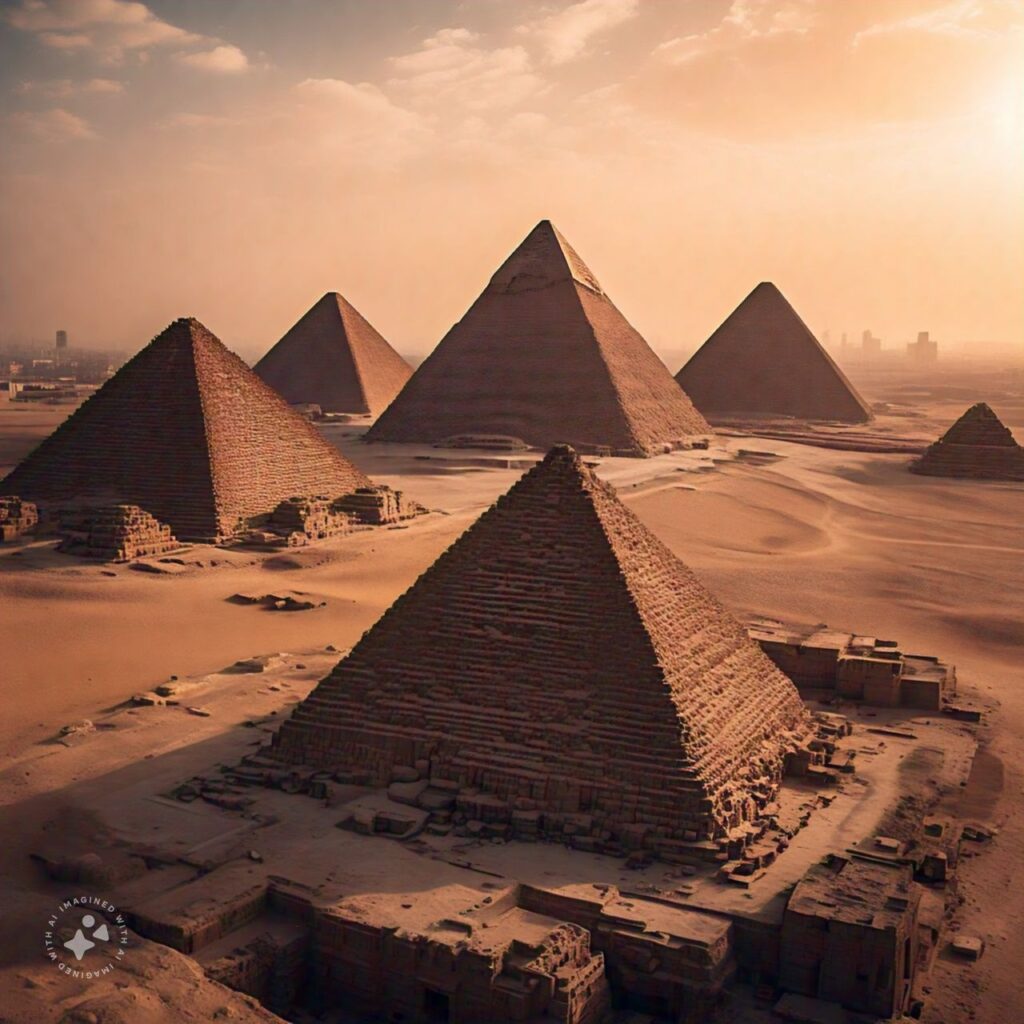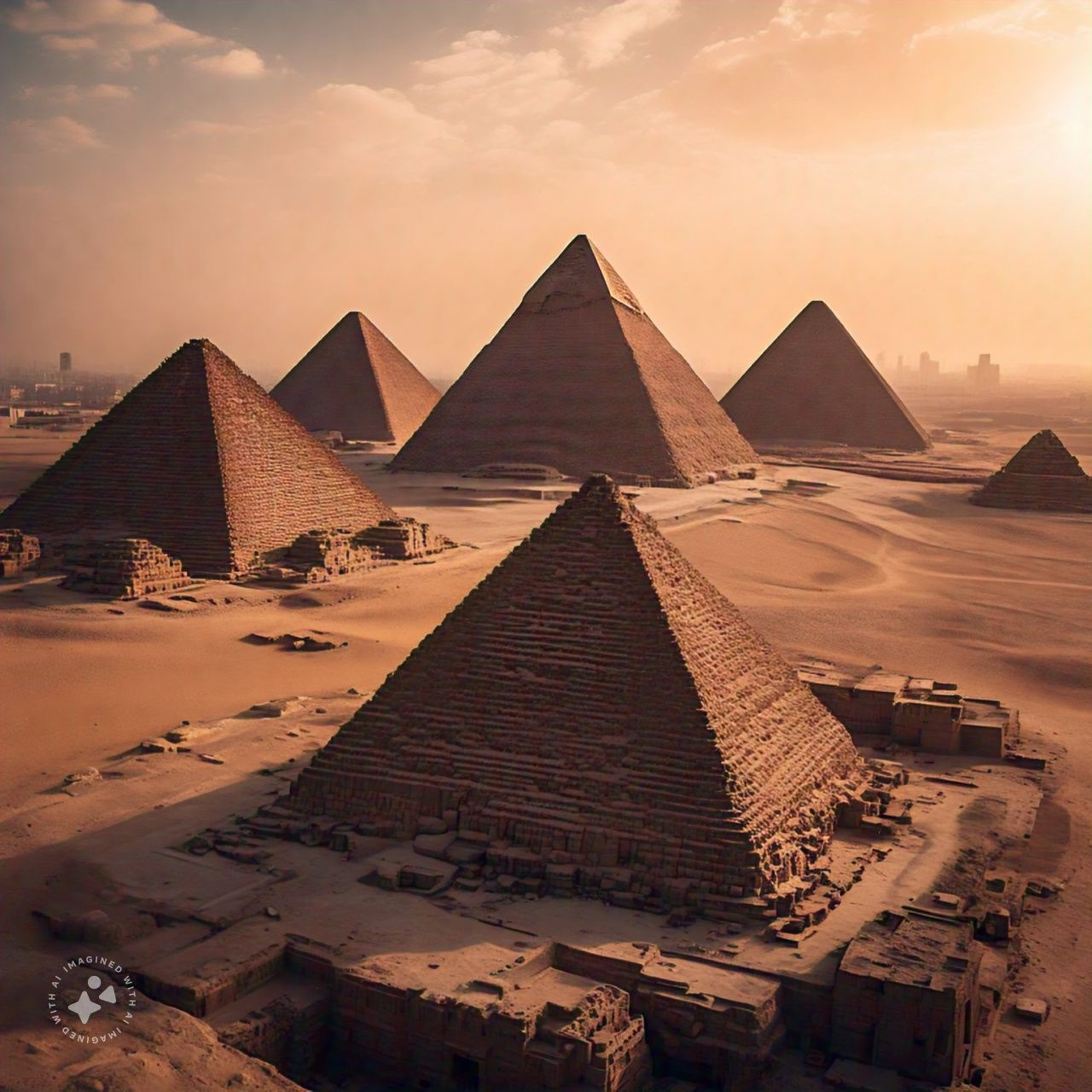The Pyramids of Giza are among the most iconic and enduring symbols of ancient Egypt. Standing as a testament to the ingenuity, skill, and ambition of one of the world’s earliest and most influential civilizations, these magnificent structures have captivated the imaginations of people across the globe for centuries. The pyramids, built as tombs for the pharaohs, are not only architectural marvels but also enduring symbols of the mysteries and grandeur of ancient Egypt.
In this article, we will explore the history, construction, and cultural significance of the Pyramids of Giza, as well as their status as one of the Seven Wonders of the Ancient World.

A Glimpse into Ancient Egypt
The Pyramids of Giza are located on the Giza Plateau, just outside of modern-day Cairo, Egypt. They were built during the Fourth Dynasty of the Old Kingdom, around 2580–2560 BCE. This period was marked by the reign of three powerful pharaohs: Khufu (also known as Cheops), his son Khafre, and his grandson Menkaure. Each of these rulers commissioned a pyramid to serve as their final resting place, as part of the ancient Egyptian belief in the afterlife.
The Egyptians believed that the pharaoh was a divine figure and that his tomb would help facilitate his journey to the afterlife, ensuring he would be reborn and continue to rule in the next world. The construction of the pyramids was not just a monumental task; it was also a religious and cultural endeavor that reflected the Egyptians’ sophisticated understanding of engineering, mathematics, and astronomy.
The Three Great Pyramids
The Giza Plateau is home to three main pyramids, each of which was built for a different pharaoh:
- The Great Pyramid of Khufu (Cheops): The largest and most famous of the three, the Great Pyramid was built for Pharaoh Khufu, who reigned around 2589–2566 BCE. Originally standing at 146.6 meters (481 feet), it was the tallest man-made structure in the world for over 3,800 years. The pyramid is constructed from an estimated 2.3 million limestone blocks, each weighing an average of 2.5 tons. The sheer scale of the Great Pyramid is staggering, and it is the only surviving wonder of the original Seven Wonders of the Ancient World.
- The Pyramid of Khafre: The second-largest pyramid, built for Khufu’s son Pharaoh Khafre, is slightly shorter than the Great Pyramid, but it appears taller due to its elevated position on the Giza Plateau. Khafre’s pyramid is unique because it retains some of the original smooth limestone casing at its summit. Adjacent to this pyramid is the famous Great Sphinx of Giza, a massive limestone statue with the body of a lion and the head of a pharaoh, believed to represent Khafre himself. The Sphinx guards the entrance to the pyramid complex.
- The Pyramid of Menkaure: The smallest of the three pyramids, built for Pharaoh Menkaure, stands at 65 meters (213 feet). Despite its smaller size, the Pyramid of Menkaure is an impressive structure, and its surrounding burial complex includes several smaller pyramids and tombs.

Each of these pyramids was originally covered in polished limestone, making them gleam in the sun. Over the millennia, most of this casing has been removed, leaving the rougher inner core exposed, but the grandeur of these structures still stands as a testament to the advanced engineering skills of ancient Egyptian builders.
The Construction of the Pyramids: Engineering Feats
The construction of the Pyramids of Giza remains one of history’s greatest architectural and engineering achievements. Despite centuries of study and research, the exact methods used to construct these enormous structures are still a matter of debate among historians and archaeologists. However, there are several key elements that experts agree on:
- Labor Force: It is widely believed that the pyramids were built by a large workforce of skilled laborers, craftsmen, and seasonal workers rather than slaves, as is often portrayed in popular culture. These workers were organized into specialized teams and were provided with food, shelter, and medical care. Evidence suggests that workers lived in nearby workers’ villages and were supported by a sophisticated supply chain.
- Materials: The construction of the pyramids required vast quantities of materials, particularly limestone. The outer casing was made of fine white limestone, while the core was built from larger, rougher limestone blocks. Granite, used for the internal chambers and the burial chamber itself, was brought from quarries located far from Giza, particularly in Aswan, more than 800 kilometers (500 miles) south of Cairo.
- Techniques: The Egyptians employed several methods to move and position the massive stones, including ramps, levers, and sledges. The most widely accepted theory is that a series of straight or zigzagging ramps were built to transport the heavy stones up to the desired height. Workers would have used ropes, wooden rollers, and manual labor to move the stones into place.
- Alignment and Precision: The pyramids are remarkably aligned with the cardinal points of the compass, and their construction demonstrates an advanced understanding of geometry and astronomy. The Great Pyramid, in particular, was constructed with incredible precision, with its sides nearly perfectly aligned to the four cardinal directions—north, south, east, and west.
The Mystery of the Pyramids
One of the most intriguing aspects of the Pyramids of Giza is the mystery surrounding their purpose and the incredible precision of their construction. While it is clear that the pyramids were built as tombs for the pharaohs, there are still many unanswered questions about the methods and exact timeline of their construction.
There are various theories about the alignment and symbolism of the pyramids, with some researchers suggesting that they were designed to align with certain stars or constellations, particularly Orion’s Belt, which was associated with Osiris, the ancient Egyptian god of the afterlife. The orientation of the pyramids may have been intended to aid the pharaoh’s journey into the afterlife, symbolizing his ascent to the heavens.
In addition, the construction of the Great Pyramid itself is still a subject of fascination. Some have speculated that the pyramid’s massive scale and precision could only have been achieved with advanced technology that was far ahead of its time. However, the prevailing view is that the ancient Egyptians relied on their knowledge of geometry, labor, and simple tools to achieve these feats, albeit with extraordinary effort and resources.

The Cultural Significance of the Pyramids
The Pyramids of Giza are not just remarkable structures of ancient engineering; they are also deeply intertwined with Egypt’s cultural and religious beliefs. The ancient Egyptians believed in an afterlife where the pharaoh would live on as a god, continuing to rule over the land from the realm of the gods. The pyramid, as a massive stone structure, was seen as a means of ensuring the pharaoh’s immortality.
The tombs inside the pyramids were richly decorated with hieroglyphic inscriptions, offering prayers, spells, and rituals designed to guide the deceased pharaoh in his journey to the afterlife. These intricate carvings, along with the treasures buried with the pharaohs, reflect the Egyptians’ deep beliefs in life after death and the divine nature of their rulers.
The Pyramids of Giza Today: A World Heritage Site
The Pyramids of Giza are one of the most visited archaeological sites in the world, attracting millions of tourists each year. In 1979, the Giza Pyramids were designated a UNESCO World Heritage Site in recognition of their historical and cultural significance. Today, they continue to stand as a testament to the advanced engineering and cultural sophistication of ancient Egypt.
Despite centuries of erosion, looting, and modern development, the pyramids still retain much of their grandeur and mystery. The surrounding pyramid complex, including the Great Sphinx, has become an essential symbol of Egypt’s rich heritage and ancient legacy.
Conclusion: The Enduring Legacy of the Pyramids
The Pyramids of Giza are not merely stone structures; they are the embodiment of ancient Egypt’s power, beliefs, and ingenuity. These monumental tombs, constructed thousands of years ago, have defied the passage of time and continue to inspire awe and fascination. As one of the most significant archaeological sites in the world, they offer a direct link to one of the most remarkable civilizations in history.
Even in the 21st century, the Pyramids of Giza remind us of the incredible achievements of ancient cultures and their lasting influence on human history. They stand as a tribute to the legacy of the pharaohs and the enduring mysteries of ancient Egypt.
